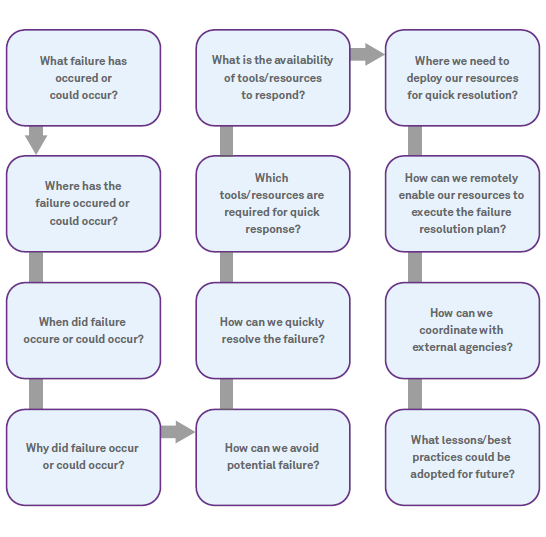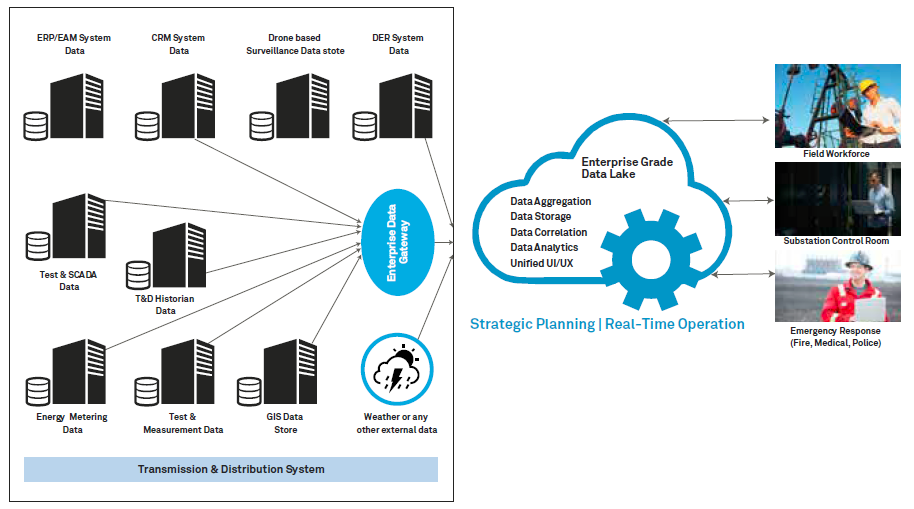Background
Over the past few years, grid modernization has emerged as the central theme of digital transformation initiatives of utilities around the world. Big data analytics remains a key pillar of all such initiatives. 1Per Frost & Sullivan’s recent analysis, data becoming central to utility operations, the global smart grid analytics market is expected to grow from US $1.15 billion in 2018 to US $2.31 billion in 2025 at a CAGR of 10.4%. With utilities investing heavily in an integrated approach to building an enterprise-grade utility data analytics platform, combining system and operations data, a new type of intelligence has been enabled for control center operators and field technicians – Situational Intelligence.
This paper intends to provide an overview of situational intelligence led operations to help utilities become more proactive and responsive in their decision-making while handling emergencies e.g. power outage due to natural disaster, fire, cyberattacks, etc.
What is Situational Intelligence?
Situational Intelligence is defined as the ability to get the right information to the right person, at the right time, to support timely and informed decisions and actions to respond to a given situation at the location of interest. An article published in Wired says, “Situational intelligence combines traditional situational awareness with the collective intelligence of those at the center of a situation, resulting in a dynamic process in which data is gathered and interpreted and the information is shared.”
When the concerned parties have access to a 3600 view of the problem and required tools, information for problem resolution; it helps minimize the operational disruption and improve overall service quality. Situational intelligence is critical not only in mitigating a crisis but also in preventing one by continuously analyzing and correlating real-time data from multiple internal/external sources and their impact on overall operations.
Why utilities need Situational Intelligence?
2Per Eaton’s Blackout Tracker Report, 36.7 million people were affected by 3,526 reported power outages in U.S. in 2017. The prevalence of power outages is evident from the fact that California had 438 power outages while Texas had 192 in 2017, with the average power outage lasting 81 minutes. Large sections of the U.S. could be left without power for months or even years should a blackout of catastrophic proportions occur, according to a draft report released by the President’s National Infrastructure Advisory Council (NIAC) in early December last year.
Climate change is a global reality today and extreme weather events are becoming more frequent and devastating every passing year. Globally, power transmission & distribution infrastructure is largely above the ground, thereby, exposing it to severe risk of disruption caused by natural disasters, e.g. floods, cyclones, hurricanes, earthquakes, heavy snow, etc. 3A 2013 US Department of Energy report states that between 2003 and 2012, roughly 679 power outages, each affecting at least 50,000 customers, occurred in the U.S. due to weather events. Over this period, weather-related outages are estimated to have cost the U.S. economy an inflation-adjusted annual average of $18 billion to $33 billion.
Though natural disasters are most prominent contributors to power outages, there are already several instances of cyberattacks on grid infrastructure leading to severe power outages, disrupting the lives of millions. According to a document posted by the North American Electric Reliability Corporation, this year on March 5, a first-of-its-kind cyberattack on the U.S. grid created blind spots at a grid control center and several small power generation sites in the western United States. Similar cyberattacks on Ukrainian utilities in 2015 and 2016 had caused hours-long outages for about a quarter-million people.
For utilities, the challenge in responding to such emergencies is actually two-fold. On the one hand, they have to mobilize the field workers to perform damage assessment of transmission & distribution assets, locate all the faults, repair the assets and restore power at the earliest. On the other hand, the control center operators have to go through multiple disjoint systems to collect and share data with all parties – utility field workers, business stakeholders, electricity consumers, government agencies, regulatory bodies, etc. Such events put huge financial strain on utilities as they may end up paying huge penalties for delay in power restoration and poor service quality to consumers, in addition to incurring the cost of restoring power services.
For example, in case of condition monitoring for critical assets (e.g. transformer, circuit breaker, isolators, etc.), some of the key questions to which situational intelligence can help utilities find answers, are–

How Situational Intelligence can be developed?
The system architecture given below provides the global view of big data analytics led situational intelligence enablement for different stakeholders in utility operations.

The Situation Intelligence solution is mainly driven by three enabling technological capabilities –
Once the utilities have seamless access to their asset and operational intelligence, applying this intelligence to improve preparedness and effectively respond to emergencies by timely mobilizing necessary workforce, resources and tools, etc. forms the most crucial element of the entire process. Utilities can achieve it by correlating and mapping the asset and operational data with workforce management data to analyze the availability and suitability of workers with respect to asset class, failure modes and geolocation, and empowering those workers with the required technical information, tools, SOPs and remote support.
What benefits can utilities expect?
Situational Intelligence based on real-time insights derived from a unified data analytics platform, combining all relevant data sources – Outage Management System (OMS), Geospatial Information System (GIS), Asset Management System, Workforce Management System, Weather Information Management System, etc. can help utilities:
How Wipro can enable Situational Intelligence for utilities
Wipro’s data, analytics and AI services enable organizations to deliver value by empowering users with more agile and intuitive processes. Our services and solutions help enhance decision-making and enable augmented intelligence and process automation, all while ensuring security, quality and regulatory compliance of data. Underpinned by technologies such as cloud, Internet of Things (IoT), Artificial Intelligence (AI), Machine Learning (ML) and advanced analytics, our framework is designed to help:
Conclusion
With cloud computing and data analytics becoming mainstream, most of the utilities are expected to move from strategy to execution mode with respect to building utilities data analytics capabilities and derive the operational value from Situational Intelligence. Wipro, with 14+ years of proven domain expertise in energy utilities, 3,500+ utilities professionals coupled with a large partner ecosystem of industry leading OEMs, communication and cloud services providers, is uniquely placed with best-in-class capabilities for delivering next-gen data analytics services to utilities around the world.
References
Anand Kumar
As part of the IoT client solutions team, Anand leads IoT solution proposals to customers across all industry segments and geographies. He is also responsible for driving joint IoT solution development proposals with strategic technology partners like Microsoft, Amazon, IBM, etc.
Leveraging his previous roles at GE and Schneider Electric, Anand brings strong IT/OT expertise of 11+ years covering industrial solutions across Power, Oil & Gas and Manufacturing. email: anand.kumar73@wipro.com